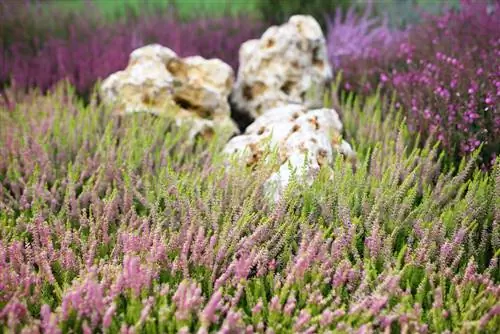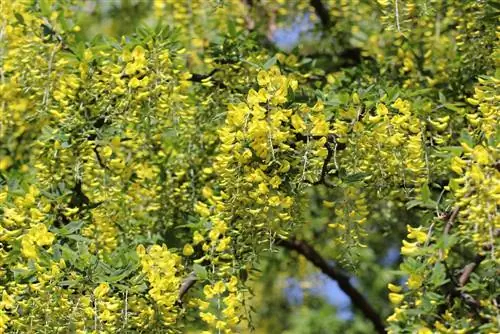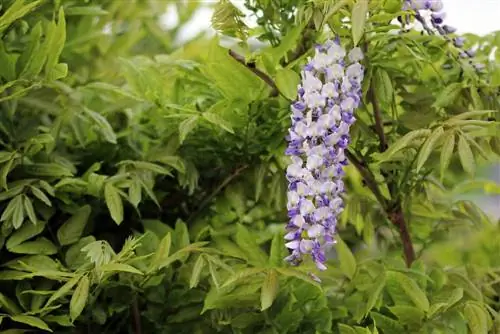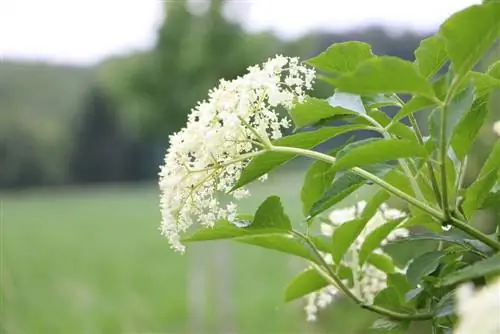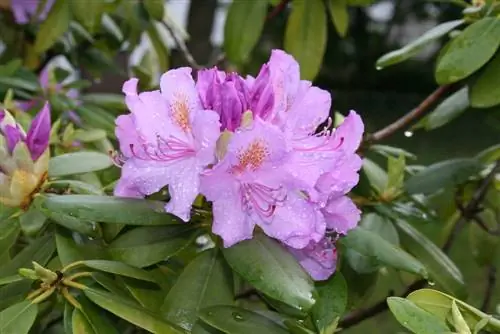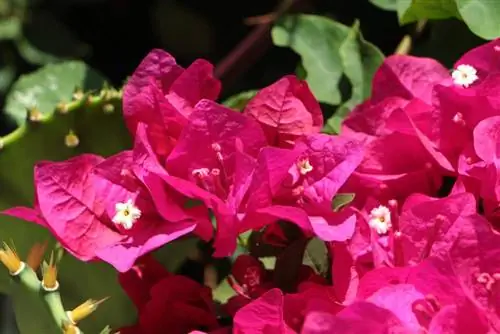- Author admin [email protected].
- Public 2023-12-17 03:39.
- Last modified 2025-01-24 12:45.
Heather is a decorative plant and can create attractive splashes of color with its flowers. However, in order to plant them specifically and admire their beauty, the flowering time of the individual species must be known. Because there are significant differences here. But it's not just the varieties that make a difference, the conditions in the respective region also play a role.
Heather species
The heather species can be roughly divided into two categories: common heather and heather. Their location and care requirements hardly differ from each other, so they can easily thrive in the same regions. However, there is a significant difference in terms of flowering time. While the common heather or Calluna vulgaris, as it is called in botanical terminology, blooms during the summer and is therefore also referred to as summer heather, the heather brings color into the winter. For this reason, Erika is appropriately called winter heath.
When the heather blooms depends primarily on the species chosen and not on the region alone. This is particularly noticeable with winter heather, because the different colors and cultivars can bloom as early as January or as late as November. The flowering period usually extends into April.
Heather landscapes in the north
In heathland landscapes in the north, such as in the well-known Lüneburg Heath in Lower Saxony, the so-called broom heather - i.e. Calluna vulgaris or summer heath - primarily thrives. Due to the region's climate, the plants bloom comparatively late. From around August, the region's areas become a sea of flowers when the heather blooms. The flowering is relatively short and only lasts until September.
As a rule of thumb and guidance, the Besenheide in the Lüneburg Heath is from August 8th. until September 9th blooms. Depending on the weather and temperatures, these dates can of course be postponed slightly. In warm and rainy years, the flowering period usually begins a little earlier. In worse conditions, however, it can take place a few days or weeks later and can also be shortened. In addition to the Lüneburg Heath, in the north you can also find:
- Misselhorn Heath
- Great Heath in Oberohe
- Hill grave heath in Kirchlinteln
- Rhododendron Park in Bremen
- Heidegarten Schneverdingen
- Heidegarten Gommern
- Park of the Gardens in Bad Zwischenahn
- Störkathener Heath
- Aukrug Nature Park
- Löwenstedter Sandberge
- Braderuper Heide
Not all of these heaths are naturally created landscapes. In some cases, such as the Aukrug Nature Park or the Schneverdingen Heidegarten, the landscapes were created and planted by people. This is intended to contribute to the preservation of biodiversity.
Heathlands in the East
The eastern heathlands are similar to the northern areas. The species diversity in terms of summer and winter heather is lower and the heather begins to bloom comparatively late. At the end of August to the beginning of September the landscapes are in full bloom, at least as far as the common heather is concerned.
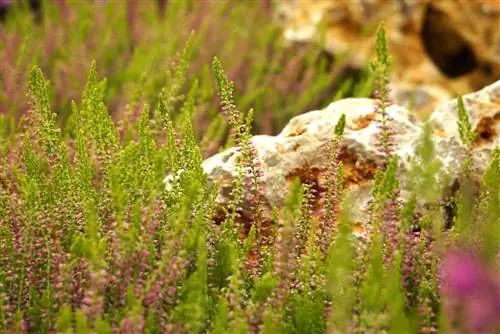
The Ericaceae or winter heather can appear as early as October. As a rule, however, it is generally more sparse. Well-known examples of heathland landscapes in the east or northeast are:
- Schorfheide in Brandenburg
- Colbitz-Letzlinger Heide
- Wittstocker Heide
- Schönower Heide
- Döberitzer Heide
- Ruhland-Königsbrücker Heide
- Elbe-Börde Heide
- Gohrischheide
- Muskauer Heide
- Rustenfelder Heide
Heathlands in the West
The heathland landscapes in the west, such as North Rhine-Westphalia, Hesse and Saarland, have greater biodiversity compared to the east and north. Therefore, just like in southern Germany, the time of flowering is difficult to predict and in turn depends on the respective species. In general, however, the flowering of the common heather begins a little earlier than in the north.
Flowering can begin around the beginning of July. The flowering period of the Erika heaths also begins a little earlier and can beautify the landscape as early as October and last throughout the winter. This means that the western heathland landscapes are usually not bathed in flowers from March or April to July. Examples of pagans in these regions include:
- Ohlsiger Heide
- Senne
- Hommershäuser Heide
- Sandheide
- Mehlinger Heide
- Reichskreuzer Heide
Note:
The heathland landscapes in the north, east and west of Germany are so-called Atlantic heaths.
Heather landscapes in the south
Southern heathland landscapes, such as those in Bavaria, Austria and Switzerland, offer a significantly greater biodiversity than the heathlands in the north. In addition to the common heather or Calluna vulgaris, various types of winter heather or heather also thrive here. The Ericaceae bloom at different times depending on the exact variety, from November to May. Common heather usually blooms a little earlier in the south than in the north. The region is often in full bloom at the end of July or beginning of August.
However, due to the greater biodiversity of the southern regions, the heather blooms almost all year round. The winter heather sometimes begins to bloom in November and shows pink, red or white flowers throughout the winter. Since there are different varieties, the beginning of the flowering period is different and the color changes over the months. Impressive examples of this include:
- Lechtalheiden
- Fröttmaninger Heide
- Borsteler Kuhlen
- Garchinger Heide
- Bruck forest and heath landscape nature reserve
- Mallertshofer Heide
- Pile Heath
In contrast to the heathlands in the north, west and east, these are not Atlantic heaths. In addition to the heather plants, numerous other plant species are also represented, so that the vegetation is generally more varied.
Heathlands in Austria
The further south the heath areas are, the greater the biodiversity. This applies not only to Germany, but also to Austria. In Austria, common heather was even voted plant of the year 2019. Examples of Austrian heath areas are:
- Welser Heide
- Hommershäuser Heide
- Kircheiber Heide
- Eidenberg moor and heath area
- Perchtelsdorfer Heide
- Parndorfer Heide
- Blockheide-Gmünd Nature Park
Heathlands in Switzerland
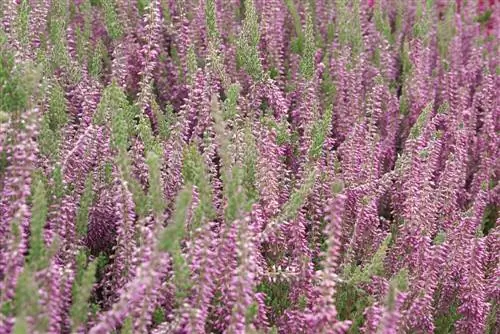
Heathland landscapes can also be found in Switzerland. Just like in the south of Germany and Austria, the areas are assigned to the non-Atlantic heaths. Well-known examples of the heath areas in Switzerland can be found in Bad Ragaz. But Lenzerheide is also a popular excursion destination.
Flowering times in the garden
If you want to plant heather, common heather or Ericaceae in the garden or use them as grave decorations and create the longest possible flowering period, you only need to consider a few points. These are:
Location
Heide is comparatively undemanding, but requires a sunny to partially shaded location. In darker places it only produces a few flowers and has a shorter flowering period.
Appropriate care
Caring for the heather is very easy and can be easily done even by beginners in plant cultivation and people without a green thumb. You just have to make sure that the substrate never dries out completely. Rainwater or generally soft, low-lime water is ideal. A fertilizer application in spring with ericaceous bed or rhododendron fertilizer maintains the flowering power. As well as a light pruning in spring.
Choose the appropriate variety
There are now numerous varieties of heather on the market. It's not just the color that should be taken into account. The flowering time and duration should also be taken into account in the decision, as there are considerable differences here. For example, the Erika variety Winter Beauty blooms from around November to April. Golden Starlett, however, only runs from March to April. If you plant different varieties, you can enjoy the flowers all year round.

